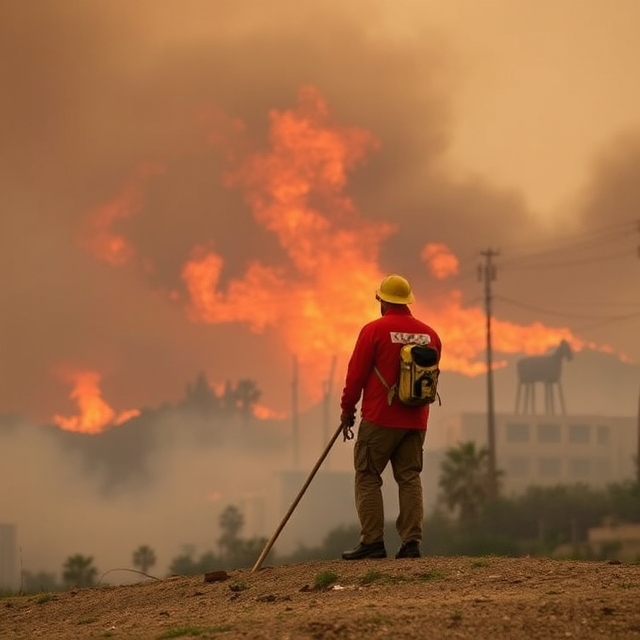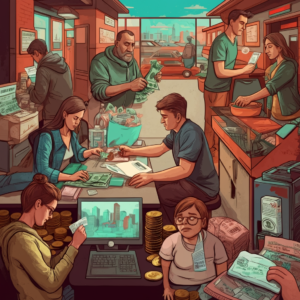Right now, wildfires are raging across Los Angeles, with huge fires like the Palisades, Eaton, and Kenneth fires causing widespread destruction.
These fires have spread quickly because of hot, dry weather and strong winds. Many areas are still under threat as firefighters work hard to stop the flames. The fires have damaged large parts of the region, including homes, businesses, and nature. Even though there’s a lot of effort to contain the fires, they continue to burn in several locations, making it a tough situation for everyone involved.
How It Is Affecting People and Communities
The fires have caused major problems for local people. Thousands of people have been forced to leave their homes to stay safe. Many homes and businesses have been destroyed, leaving families without a place to live or work. The fire is also causing disruptions in everyday life, with evacuation orders making it hard for people to know what to do or where to go.
Essential services like power and water have been cut off in many areas, making things even harder for those affected. The emotional toll on people is huge, as they face the fear of losing their homes or loved ones. Emergency teams are doing their best to provide food, shelter, and medical care for people, but the situation remains difficult. The damage from these wildfires will take a long time to fix, and recovery will not be easy.
Despite the challenges, the community’s strength and support is shining through as neighbors, responders, and officials come together to help those in need during this crisis.
Evacuations: Where Are People Going?
Large Numbers of People Are Leaving Their Homes
As wildfires continue to spread across Los Angeles, a large number of residents are being forced to evacuate their homes in order to protect themselves and their families. With the fires quickly advancing toward populated areas, evacuation orders have been issued for several neighborhoods. These orders have resulted in the displacement of thousands of people who are now seeking safety elsewhere. The situation has caused great panic and uncertainty, with many individuals uncertain about whether their homes will be spared or destroyed.
For some, evacuating means leaving behind everything they know, and many are still trying to figure out the best places to go. The sheer number of evacuees has created an overwhelming demand for shelter and assistance. As people leave their homes in fear of the fires, the emotional toll of having to suddenly uproot and abandon their properties is taking a heavy toll on the local population.
Safe Places to Stay and How People Are Being Helped
In response to the growing number of evacuees, emergency shelters have been established throughout Los Angeles to provide safety for those fleeing the fires. These shelters, often set up in community centers, schools, or other large buildings, offer a temporary safe haven for people who have had to leave their homes. While these shelters provide a place for people to sleep, they also offer food, water, and basic necessities to ensure the well-being of evacuees during this difficult time.
Alongside the shelters, local authorities and organizations are working to distribute essential supplies such as clothing, blankets, and toiletries to those affected by the fires. Volunteers and emergency services have been working tirelessly to ensure that evacuees are supported and receive the assistance they need. In some cases, local businesses, hotels, and even private homes have opened their doors to accommodate those in need, offering additional places for people to stay.
For those unable to access emergency shelters, other forms of assistance, such as transportation, are being provided to ensure that people can reach safe areas away from the fires. Local officials have coordinated with neighboring towns and cities to establish evacuation routes, directing people to areas where they can find shelter and resources. Emergency responders are also working closely with organizations to provide medical care to evacuees who may need immediate attention.
Although the situation remains dire, the community’s efforts to support one another during this crisis are helping to ease some of the hardships faced by those affected by the wildfires. While the process of evacuating and finding shelter is overwhelming, these efforts are vital in ensuring that people can stay safe and receive the necessary help during the fires.
What Are People Doing Now?
How People Are Coping with Losing Their Homes
For many people in Los Angeles, the wildfires have caused heartbreaking losses. The fear of losing everything they have worked for has turned into a painful reality. With entire neighborhoods destroyed by the flames, many evacuees are now facing the emotional and practical challenges of rebuilding their lives. For some, the most immediate concern is finding a place to stay while dealing with the uncertainty of what they will return to, or if they will have a home to return to at all.
Coping with the loss of homes is a long, emotional process. Many residents have spent years in their homes, building memories, and forming connections with their neighbors and communities. For them, the loss is not just physical, but emotional as well. To manage, people are finding comfort in their families, friends, and support networks. There is a sense of shared resilience, as people come together to help each other cope with the trauma of losing their homes and personal belongings. Mental health support is also available, as communities and organizations recognize the importance of addressing the psychological toll these wildfires have taken on those affected.
Stories of People Looking for Their Families and Help
In the chaos of evacuations and displacement, many individuals have been separated from their families or loved ones. Some people are desperately trying to find relatives who were unable to leave in time, or who were in other parts of the city when the fires spread. Local authorities and support organizations have set up help lines, online databases, and community outreach programs to help people reunite with their families. However, the uncertainty and stress of not knowing where loved ones are can make this process even harder for evacuees.
Stories of survival and rescue are emerging as well, with neighbors helping neighbors and strangers offering support to those in need. Volunteers have stepped in to assist people in getting to safety, providing food, and offering emotional support. There is a growing network of aid, and it is through these connections that many are finding hope amidst the disaster.
Challenges of Staying in Shelters and Temporary Homes
While emergency shelters provide immediate safety, they come with their own set of challenges. For many evacuees, these shelters are a temporary solution to an overwhelming crisis. The conditions in some shelters are crowded, with people sleeping in close quarters and limited privacy. This can lead to stress and tension as families adjust to living in temporary spaces. Additionally, access to basic needs like food, medical care, and personal hygiene items may be limited, adding further pressure on already exhausted evacuees.
For those staying with relatives or in temporary housing, there are also challenges related to space and safety. While it may provide comfort to be with loved ones, many families are unsure of how long they can stay in these temporary situations. The uncertainty of whether they will be able to return to their homes or if they will need to start over completely adds to the stress of the situation.
Despite these challenges, the resilience of people continues to shine through. Communities are working together to support each other, providing not just material assistance, but also a sense of hope and connection during these difficult times. The road to recovery is long, but with the continued support of the community and organizations, people are finding ways to cope and move forward.
Helping Each Other: Community Support
Neighbors and Volunteers Coming Together to Help
In the wake of the wildfires, one of the most remarkable aspects of this crisis has been the outpouring of support from neighbors and volunteers. People who have been affected by the fires are not facing this disaster alone; they are being supported by those around them. Neighbors are opening their homes to those who have been displaced, offering shelter, food, and emotional comfort. Local volunteers are working tirelessly to assist with evacuation efforts, direct people to safety, and provide guidance on where to find resources. Many individuals who were also evacuated are stepping in to help others, showing the power of community solidarity during difficult times.
Local volunteer organizations have mobilized quickly, with many offering their time to help with search and rescue efforts, distributing supplies, and providing medical assistance. In some cases, volunteers have even traveled from other regions to provide support. This selfless spirit of helping others is evident in all corners of Los Angeles, as people come together to support those most affected by the fires.
Donations, Food, and Supplies Being Given to Those in Need
As people lose their homes and belongings, donations are pouring in from all over the country. Local businesses, individuals, and charitable organizations are providing critical supplies, including food, water, clothing, and bedding. Food drives have been organized to ensure that evacuees have enough to eat, while community kitchens and shelters are serving hot meals to those in need. Organizations have also set up online donation platforms to raise money for wildfire victims, allowing people from all over the world to contribute to the recovery efforts.
Many shelters and community centers are also collecting supplies like blankets, personal hygiene products, and medicine to support those staying in temporary accommodations. These donations are helping to meet the basic needs of evacuees, ensuring that they can survive in the short term as they wait to see what happens with the fires. The generosity of the public has been overwhelming, and these efforts are making a big difference in the lives of those who have lost everything.
How People Are Helping Each Other in Tough Times
In times of crisis, the strength of the human spirit shines through, and in Los Angeles, this is no exception. Beyond material donations, many people are offering their emotional support to those affected by the fires. Neighbors are comforting each other, sharing news and updates, and offering a listening ear. In some cases, people have opened up their homes to evacuees, providing a temporary place of refuge and normalcy. The sense of camaraderie and mutual aid is helping to rebuild the emotional well-being of those impacted by the disaster.
Social media has played a crucial role in connecting people and organizing relief efforts. Many community groups and individuals have used online platforms to share updates, raise awareness, and organize fundraisers. These efforts have helped to connect those in need with those who are able to help. The outpouring of support from across Los Angeles and beyond is a powerful reminder of the importance of community in times of crisis.
As the wildfires continue, the spirit of helping each other remains strong. People are coming together, not only to meet the immediate needs of evacuees but also to support the long-term recovery and healing of the community. The crisis has shown that even in the toughest of times, people can find strength in each other and build resilience together.
What is the Government Doing?
Emergency Services Helping with Evacuations
In response to the rapidly spreading wildfires, government agencies and emergency services have mobilized quickly to support evacuations and protect the public. Local authorities have issued evacuation orders for affected areas, ensuring that people have a clear path to safety. Firefighters, police officers, and paramedics are working tirelessly to assist in evacuations, guiding residents out of dangerous areas, and ensuring they reach safe locations. The government has coordinated transportation efforts to help people who may not have the means to evacuate on their own, using buses, emergency vehicles, and other resources to transport evacuees to safe zones.
Additionally, search and rescue teams have been deployed to help people who may be trapped in their homes or unable to evacuate. Shelters have been set up across the region to house those forced to leave their homes. These emergency services are working around the clock to minimize harm to residents and ensure that as many people as possible are safely evacuated from the affected areas.
What Authorities Are Doing to Fight the Fires and Help People
Fighting the wildfires requires significant resources, and government agencies are putting everything they can into containing the flames. Firefighting teams from local, state, and federal levels have been mobilized, with hundreds of firefighters battling the flames on the frontlines. Authorities have deployed air tankers, helicopters, and ground crews to stop the fires from spreading further. These efforts are being complicated by high winds and dry conditions, but emergency responders are adapting their strategies to the changing circumstances.
In addition to firefighting efforts, emergency medical teams have been dispatched to care for those affected by the fires. People suffering from smoke inhalation or other injuries are being treated at emergency response centers, where medical staff are providing urgent care. Local hospitals are on alert, preparing for an influx of patients as the fires continue. The government has also coordinated with utility companies to restore power and water to areas where it has been lost due to the fires, providing essential services to evacuees and first responders.
Furthermore, the authorities are working with volunteers and non-governmental organizations (NGOs) to provide food, clothing, and other essential supplies to those in need. The cooperation between government agencies and humanitarian organizations is critical to ensuring that every evacuee receives the support they require during this crisis.
Plans for Recovery and Rebuilding After the Fires
The government is already looking ahead to the long-term recovery and rebuilding efforts that will be necessary after the fires are under control. Once the fires are contained, local and state authorities will begin assessing the damage to homes, infrastructure, and the environment. Plans will be put in place to assist residents in rebuilding their homes and businesses, including providing financial assistance and temporary housing.
In addition to immediate recovery, officials are focused on ensuring that future disasters are better managed. Building codes may be adjusted to make homes more fire-resistant, and firebreaks will be created to help prevent wildfires from spreading in the future. The government is also likely to invest in more fire prevention programs, such as controlled burns, forest management, and community education about how to stay safe during wildfire season.
Government officials have committed to providing mental health support to those who have been affected by the fires. The trauma of losing homes and loved ones can have a lasting impact, and recovery efforts will include access to counseling and other services to help people heal. The rebuilding process will take time, but the government’s comprehensive plans will focus on both physical and emotional recovery for those affected by the disaster.
Public Reaction: How Are People Reacting?
How People on Social Media Are Sharing Their Experiences
Social media has become a powerful tool for people affected by the wildfires to share their experiences, raise awareness, and seek help. Many individuals have turned to platforms like Twitter, Facebook, Instagram, and TikTok to post real-time updates about the fires, offer support to evacuees, and document the damage to their homes and communities. These platforms have become a lifeline, allowing people to stay connected and informed about evacuation orders, safe zones, and emergency services.
Personal stories are being shared, from accounts of evacuations to expressions of concern for loved ones. People are also using social media to offer assistance, whether it’s by sharing available resources, promoting donation drives, or coordinating volunteer efforts. In some cases, livestreams and videos from the affected areas have shown the scale of the destruction, helping to raise awareness about the severity of the fires and the ongoing efforts to contain them.
Social media has also allowed for messages of solidarity, with people expressing their support for those affected by the fires. Hashtags like #LosAngelesFires or #LAstrong have emerged as ways for people to find each other and offer encouragement, support, and resources.
Support from Other Parts of the World
As the fires in Los Angeles have captured the world’s attention, people and organizations from across the globe have offered their support to those affected. International relief efforts have begun, with people donating money, supplies, and services to aid in the recovery process. Many foreign governments have expressed their solidarity with the U.S., offering both moral support and assistance. In some cases, countries with experience in wildfire management have offered expertise and firefighting resources to help control the flames.
The response from around the world is a testament to the global awareness of the severity of the situation. Organizations like the Red Cross, United Nations, and various humanitarian groups have raised funds and sent teams to help evacuees, providing them with food, shelter, and medical care. The outpouring of support has shown that when a disaster strikes, people across the globe are willing to come together to help those in need, no matter where the crisis occurs.
How the Media Is Covering the Wildfires
The media has played a critical role in informing the public about the wildfires and their impact on Los Angeles. News outlets, both local and national, have been providing continuous coverage of the fires, highlighting the extent of the destruction, the evacuation efforts, and the challenges faced by emergency responders. Through television reports, live broadcasts, and news articles, the media has been giving real-time updates to ensure that the public is informed about safety measures and developments.
The media has also been instrumental in showing the human side of the disaster, sharing personal stories of people affected by the fires and showing how the community is coming together in the face of adversity. Coverage often includes interviews with residents, first responders, and officials, giving a well-rounded picture of how the situation is unfolding.
Additionally, the media has helped to amplify calls for donations and support, publicizing relief efforts and encouraging people to contribute in any way they can. The coverage has also sparked conversations about climate change, fire prevention, and the need for more effective disaster preparedness in the future. The media’s role in both reporting the crisis and fostering global awareness is essential in the recovery process and in helping to mobilize resources for those affected by the wildfires.
What Will Happen Next?
What Evacuees Are Planning to Do in the Future
For many evacuees, the immediate concern is finding a safe place to stay while they figure out what comes next. Many people are still uncertain about the future of their homes and communities. Some evacuees are staying with relatives, in shelters, or in temporary housing, while they wait for updates on the condition of their homes. As evacuation orders are lifted, some are cautiously returning to assess the damage, but for many, the future remains unclear.
In the coming weeks and months, evacuees will begin the long process of rebuilding their lives. Some may decide to stay in temporary housing while they search for permanent homes, while others might choose to relocate permanently, depending on the extent of the destruction. Insurance claims and government assistance will play a crucial role in helping evacuees recover, but rebuilding is expected to take time. Many are also looking to support networks to help them cope emotionally with the trauma of losing their homes.
As they plan their next steps, evacuees are also looking for ways to prepare for future emergencies. Some people are becoming more involved in local fire prevention initiatives, while others are making adjustments to their homes and daily routines to make them safer in the event of another disaster. The desire to rebuild is strong, but the experience has shown many evacuees the importance of being better prepared for the future.
How People Are Getting Ready in Case of More Fires
In the wake of these devastating wildfires, many residents are taking proactive steps to be ready in case of future fires. Local authorities are providing guidelines on creating emergency evacuation plans, ensuring that people have a clear strategy to follow if they need to leave quickly. Many are updating their emergency kits, ensuring that they have essentials like food, water, flashlights, first-aid supplies, and important documents ready to go in case they need to evacuate again.
Additionally, residents are taking steps to make their homes more fire-resistant. This includes clearing dry vegetation around their properties, trimming trees, and creating firebreaks to reduce the risk of wildfires spreading. Some people are also considering home improvements, like fireproof roofing materials or non-flammable fences, to better protect their homes in the future.
Communities are also coming together to discuss fire prevention strategies, organizing workshops and safety programs to teach people how to reduce the risk of wildfires. These community-wide efforts are helping everyone stay more informed and prepared for future emergencies.
The Steps to Rebuild Homes and Communities After the Fires
Once the wildfires are under control, the long and challenging process of rebuilding begins. Government agencies and nonprofit organizations will play key roles in helping communities recover. Insurance claims, financial assistance, and disaster relief programs will help people rebuild their homes and businesses. Temporary housing solutions will also be in place for those whose homes are completely destroyed or deemed uninhabitable.
In addition to physical reconstruction, there will be a focus on mental health support. Many people will need counseling and emotional support to cope with the trauma of losing their homes, belongings, and, in some cases, loved ones. Community organizations, mental health professionals, and government services will work together to provide these resources.
The rebuilding of infrastructure—such as roads, utilities, and schools—will also be a priority. These efforts will require coordination between local, state, and federal agencies, as well as private companies, to ensure that essential services are restored as quickly as possible.
Rebuilding communities will take time, but the resilience of the people affected by the wildfires, along with the support from the broader community, will help them come back stronger. As people start to rebuild their homes, the focus will also be on ensuring that future disasters are better prepared for and that communities are more resilient to fires in the years to come.
Conclusion: Staying Strong
How People Are Staying Strong and Supporting Each Other
In the face of overwhelming adversity, the people of Los Angeles have shown remarkable strength and unity. Despite the destruction caused by the wildfires, communities have come together to support one another, offering help, comfort, and resources. Neighbors, family members, and friends are standing by each other, sharing what they can, and helping evacuees find safety and shelter. Even those who have lost their own homes are stepping forward to assist others, displaying incredible generosity and resilience.
Volunteer groups and local organizations have been instrumental in providing aid, and many individuals are dedicating their time and energy to helping their neighbors. The spirit of solidarity and compassion is what is helping people get through the toughest of times. Whether it’s by offering emotional support, donating supplies, or coordinating evacuation efforts, the community’s response is a testament to the strength of human connection in times of crisis.
The Road to Recovery and Hope for the Future
The road to recovery will be long and challenging, but the people of Los Angeles have shown that they are not facing this crisis alone. With the support of the community, local authorities, and organizations, there is hope for a brighter future. As the fires are brought under control and the recovery process begins, efforts to rebuild homes, businesses, and infrastructure will be underway.
Beyond physical rebuilding, the emotional and psychological recovery will be just as important. People will continue to lean on each other, find strength in shared experiences, and work together to heal. The road to recovery may take time, but it will be paved with the determination, kindness, and resilience of those who have been affected.
Looking forward, there is hope that lessons learned from this tragedy will lead to better fire prevention, disaster preparedness, and community resilience in the future. People are taking steps now to ensure that they are better prepared for any future disasters, and there is a sense of collective determination to come out stronger on the other side.
In the end, the strength of the community, the support from around the world, and the unwavering determination of individuals to rebuild and recover will carry Los Angeles forward. The wildfires may have caused devastation, but they have also sparked a powerful spirit of hope and solidarity that will help people move toward a brighter future.









